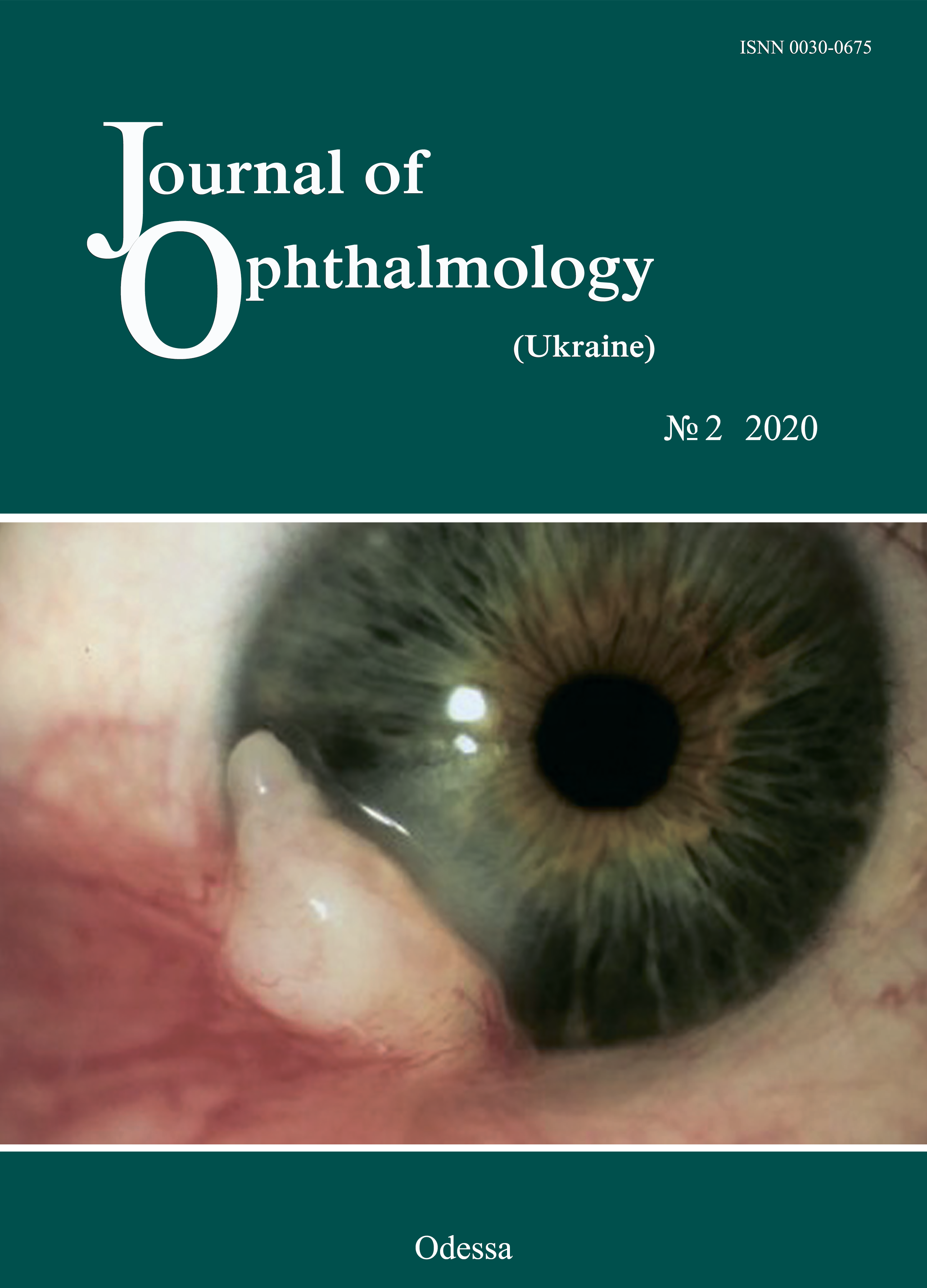Роль поліморфних варіантів генів -174 G/C IL6 та -1082G/A і -592C/A IL10 у патогенезі кератоконуса та розвитку рецидивуючих ерозій при гратчастій дистрофії рогівки у пацієнтів з України
DOI:
https://doi.org/10.31288/oftalmolzh20202311Ключові слова:
кератоконус, гратчаста дистрофія рогівки, рецидивуючі ерозії, клінічний фенотип, поліморфізм генів інтерлейкінів, спадкова схильністьАнотація
Вступ. Кератоконус (КК), ектазія рогівки, є мультифакторним захворюванням зі спадковою схильністю, яке зустрічається у 1:2000 населення. Гратчаста дистрофія строми рогівки є найбільш поширеним в Україні типом (40,2%) серед інших видів спадкових дистрофій – моногенних захворювань, зумовлених мутаціями в гені TGFBI з варіюючими фенотиповими клінічними проявами.
Мета: з’ясувати роль поліморфних варіантів генів -174 G/C IL6 та -1082G/A і -592C/A IL10 як факторів спадкової схильності до розвитку кератоконусу, а також рецидивуючих ерозій у пацієнтів з гратчастою дистофією рогівки з України.
Матеріал і методи. Офтальмологічне дослідження проводили з використанням біомікроскопії, офтальмоскопії, кератотопографії, пахіметрії, дистанційної біометрії, гоніоскопії, тонометрії. Генотипування за поліморфними варіантами генів -174 G/C IL6, -1082G/A і -592C/A IL10 проводили з використанням аналізу рестрикції фрагментів продуктів ПЛР на ДНК-матриці послідовності відповідних поліморфних локусів. Для статистичного аналізу використовували Fexact-тест.
Результати. Встановлено, що частота гомозигот (АА) за IL10 rs1800896 була вищою серед хворих з КК (0,25) порівняно з частотою таких індивідів у контрольній групі (0,19). Частота гомозигот (CC) серед хворих з кератоконусом (0,18) за поліморфним локусом -174 G/C гена IL6 була нижче у порівнянні з частотою індивідів з таким генотипом в контрольній групі (0,22). Отримані дані не досягають порогу значущості, але вказують на тенденцію до асоціації поліморфних варіантів -1082G/A IL10 та -174 G/C гена IL6 з ризиком розвитку кератоконуса. В свою чергу, частота носіїв алеля C гена IL6 у пацієнтів з гратчастою дистрофією і рецидивуючими ерозіями (0,78) була достовірно вищою (р<0,05), ніж серед індивідів з контрольної групи (0,66). Також в групі пацієнтів з рецидивуючими ерозіями частота (0,48) носіїв алеля A гена IL10 rs1800872 достовірно (р<0,05) перевищувала частку носіїв цього алеля (0,33) в контрольній групі.
Висновок. За результатами проведених досліджень встановлено, що поліморфізми -174G/С гена IL6, -592С/A rs1800872 та -1082G/A rs1800896 гена IL10 разом з генами-детермінаторами створюють кумулятивний ефект модифікаторів клінічного фенотипу при кератоконусі та гратчастій дистрофії рогівки.
Посилання
1.Kennedy RH, Bourne WM, Dyer JA. A 48-year clinical and epidemiologic study of keratoconus. Am J Ophthalmol. 1986 Mar 15;101(3):267-73. https://doi.org/10.1016/0002-9394(86)90817-2
2.Dronov MM, Pirogov IuI. [Keratoconus: Types, Etiology and Pathogenesis. Part 1]. Oftalmokhirurgiia i terapiia. 2002;2:33-7. Russian.
3.Sevost'ianov EN, Gorskova EN, Ekgardt VF. [Keratoconus (ethiology, pathogenesis, and medicinal treatment): a tutorial]. Cheliabinsk: UGMADO; 2005. Russian.
4.Birich TA, Chekina AIu, Aksenova NI. [Treatment outcomes for patients with keratoconus]. Oftalmologiia Belarusi. 2010;1(4). Russian.
5.Nowak DM, Gajecka M. The genetics of keratoconus. Middle East Afr J Ophthalmol. 2011 Jan;18(1):2-6.https://doi.org/10.4103/0974-9233.75876
6.Karimian F, Aramesh S, Rabei HM, Javadi MA, Rafati N. Topographic evaluation of relatives of patients with keratoconus. Cornea. 2008 Sep;27(8):874-8.https://doi.org/10.1097/ICO.0b013e31816f5edc
7.Owens H, Gamble G. A profile of keratoconus in New Zealand. Cornea. 2003;22:122-25.https://doi.org/10.1097/00003226-200303000-00008
8.Aknin C, Allart JF, Rouland JF. [Unilateral keratoconus and mirror image in a pair of monozygotic twins]. J Fr Ophtalmol. 2007 Nov;30(9):899-902.https://doi.org/10.1016/S0181-5512(07)74025-1
9.Weed KH, MacEwen CJ, McGhee CN. The variable expression of keratoconus within monozygotic twins: dundee University Scottish Keratoconus Study (DUSKS). Cont Lens Anterior Eye. 2006 Jul;29(3):123-6.https://doi.org/10.1016/j.clae.2006.03.003
10.Schmitt-Bernard C, Schneider CD, Blanc D, Arnaud B. Keratographic analysis of a family with keratoconus in identical twins. J Cataract Refract Surg. 2000 Dec;26(12):1830-2.https://doi.org/10.1016/S0886-3350(00)00556-3
11.Parker J, Ko WW, Pavlopoulos G, Wolfe PJ, Rabinowitz YS, et al. Videokeratography of keratoconus in monozygotic twins. J Refract Surg. 1996 Jan-Feb;12(1):180-3.https://doi.org/10.3928/1081-597X-19960101-31
12.Hughes AE, Dash DP, Jackson AJ, Frazer DG, Silvestri G. Familial keratoconus with cataract: linkage to the long arm of chromosome 15 and exclusion of candidate genes. Invest Ophthalmol Vis Sci. 2003 Dec;44(12):5063-6.https://doi.org/10.1167/iovs.03-0399
13.Rabinowitz YS. The genetics of keratoconus. Ophthalmol Clin North Am. 2003 Dec;16(4):607-20, vii.https://doi.org/10.1016/S0896-1549(03)00099-3
14.Wheeler J, Hauser MA, Afshari NA, Allingham RR, Liu Y. The Genetics of Keratoconus: A Review. Reprod Syst Sex Disord. 2012 Jun 3;(Suppl 6).
15.Dimasi DP, Burdon KP, Craig JE. The genetics of central corneal thickness. Br J Ophthalmol. 2010 Aug;94(8):971-6.https://doi.org/10.1136/bjo.2009.162735
16.Pedersen U, Bramsen T. Central corneal thickness in osteogenesis imperfecta and otosclerosis. ORL J Otorhinolaryngol Relat Spec. 1984;46(1):38-41.https://doi.org/10.1159/000275682
17.Evereklioglu C, Madenci E, Bayazit YA, et al. Central corneal thickness is lower in osteogenesis imperfecta and negatively correlates with the presence of blue sclera. Ophthalmic Physiol Opt. 2002 Nov;22(6):511-5.https://doi.org/10.1046/j.1475-1313.2002.00062.x
18.Cohen EJ, Myers JS. Keratoconus and normal-tension glaucoma: a study of the possible association with abnormal biomechanical properties as measured by corneal hysteresis. Cornea. 2010 Sep;29(9):955-70.https://doi.org/10.1097/ICO.0b013e3181ca363c
19.Gordon M.O, et al. The Ocular Hypertension Treatment Study: baseline factors that predict the onset of primary open-angle glaucoma. Arch Ophthalmol. 2002 Jun;120(6):714-20; discussion 829-30.https://doi.org/10.1001/archopht.120.6.714
20.Cornes BK, Khor CC, Nongpiur MI, et al. Identification of four novel variants that influence central corneal thickness in multi-ethnic Asian populations. Hum Mol Genet. 2012 Jan 15;21(2):437-45.https://doi.org/10.1093/hmg/ddr463
21.Lu Y, Dimasi DP, Hysi PG, et al. Common genetic variants near the Brittle Cornea Syndrome locus ZNF469 influence the blinding disease risk factor central corneal thickness. PLoS Genet. 2010 May 13;6(5):e1000947.https://doi.org/10.1371/journal.pgen.1000947
22.Vitart V, Benci? G, Hayward C, et al. New loci associated with central cornea thickness include COL5A1, AKAP13 and AVGR8. Hum Mol Genet. 2010 Nov 1;19(21):4304-11.https://doi.org/10.1093/hmg/ddq349
23.Vithana EN, Aung T, Khor CC, et al. Collagen-related genes influence the glaucoma risk factor, central corneal thickness. Hum Mol Genet. 2011 Feb 15;20(4):649-58.https://doi.org/10.1093/hmg/ddq511
24.Burdon KP, Macgregor S, Bykhovskaya Y, et al. Association of Polymorphisms in the Hepatocyte Growth Factor Gene Promoter with Keratoconus. Invest Ophthalmol Vis Sci. 2011 Oct 31;52(11):8514-9.https://doi.org/10.1167/iovs.11-8261
25.Chwa M, Atilano SR, Reddy V, Jordan N, Kim DW, Kenney MC. Increased stress-induced generation of reactive oxygen species and apoptosis in human keratoconus fibroblasts. Invest Ophthalmol Vis Sci. 2006 May;47(5):1902-10.https://doi.org/10.1167/iovs.05-0828
26.Balasubramanian SA, Mohan S, Pye DC, Willcox MD. Proteases, proteolysis and inflammatory molecules in the tears of people with keratoconus. Acta Ophthalmol. 2012 Jun;90(4):e303-9.https://doi.org/10.1111/j.1755-3768.2011.02369.x
27.Lema I, Duran JA. Inflammatory molecules in the tears of patients with keratoconus. Ophthalmology. 2005 Apr;112(4):654-9.https://doi.org/10.1016/j.ophtha.2004.11.050
28.Lema I, Sobrino T, Duran JA, Brea D, Diez-Feijoo E. Subclinical keratoconus and inflammatory molecules from tears. Br J Ophthalmol. 2009 Jun;93(6):820-4.https://doi.org/10.1136/bjo.2008.144253
29.Nemet AY, Vinker S, Bahar I, Kaiserman I. The association of keratoconus with immune disorders. Cornea. 2010 Nov;29(11):1261-4.https://doi.org/10.1097/ICO.0b013e3181cb410b
30.Wisse RP, Kuiper JJ, Gans R, Imhof S, Radstake TR, Van der Lelij A. Cytokine expression in keratoconus and its corneal microenvironment: a systematic review. Ocular Surf. 2015 Oct;13(4):272-83.https://doi.org/10.1016/j.jtos.2015.04.006
31.Jun AS, Cope L, Speck C, et al. Subnormal cytokine profile in the tear fluid of keratoconus patients. PLoS One. 2011 Jan 27;6(1):e16437.https://doi.org/10.1371/journal.pone.0016437
32.Temple S, Lim E, Cheong K, et al. Alleles carried at positions ?819 and ?592 of the IL10 promoter affect transcription following stimulation of peripheral blood cells with Streptococcus pneumoniae. Immunogenetics. 2003;55:629-32.https://doi.org/10.1007/s00251-003-0621-6
33.Costa GC, da Costa Rocha MO, Moreira PR, et al. Functional IL-10 Gene Polymorphism Is Associated with Chagas Disease Cardiomyopathy. J Infect Dis. 2009 Feb 1;199(3):451-4.https://doi.org/10.1086/596061
34.Agrawal VB, Tsai RJ. Corneal epithelial wound healing. Indian J Ophthalmol. 2003 Mar;51(1):5-15.
35.Wilson SE, Mohan RR, Ambr?sio R, et al. The corneal wound healing response: cytokine-mediated interaction of the epithelium, stroma, and inflammatory cells. Prog Retin Eye Res. 2001 Sep;20(5):625-37.https://doi.org/10.1016/S1350-9462(01)00008-8
36.Ebihara N, Matsuda A, Nakamura S, et al. Role of the IL-6 classic- and trans-signaling pathways in corneal sterile inflammation and wound healing. Invest Ophthalmol Vis Sci. 2011 Nov 1;52(12):8549-57.https://doi.org/10.1167/iovs.11-7956
37.Sotozono C, He J, Matsumoto Y, et al. Cytokine expression in the alkali-burned cornea. Curr Eye Res. 1997 Jul;16(7):670-6.https://doi.org/10.1076/ceyr.16.7.670.5057
38.Ferrari SL, Ahn-Luong L, Garnero P, et al. Two promoter polymorphisms regulating interleukin-6 gene expression are associated with circulating levels of C-reactive protein and markers of bone resorption in postmenopausal women. J Clin Endocrinol Metab. 2003 Jan;88(1):255-9.https://doi.org/10.1210/jc.2002-020092
39.Fishman D, Faulds G, Jeffery R, et al. The effect of novel polymorphisms in the interleukin-6 (IL-6) gene on IL-6 transcription and plasma IL-6 levels, and an association with systemic-onset juvenile chronic arthritis. J Clin Invest. 1998 Oct 1;102(7):1369-76.https://doi.org/10.1172/JCI2629
40.Kristiansen OP, Nols?e RL, Larsen L, et al. Association of a functional 17beta-estradiol sensitive IL6-174G/C promoter polymorphism with early-onset type 1 diabetes in females. Hum Mol Genet. 2003 May 15;12(10):1101-10.https://doi.org/10.1093/hmg/ddg132
41.Kucherenko AM, Pampukha VM, Drozhzhyna GI, Livshits LA. IL1beta, IL6 and IL8 gene polymorphisms involvement in recurrent corneal erosion in patients with hereditary stromal corneal dystrophies. Tsitol Genet. 2013 May-Jun;47(3):42-5.https://doi.org/10.3103/S0095452713030055
42.Yi Lu, Vitart V, Burdon KP, et al. Genome-wide association analyses identify multiple loci associated with central corneal thickness and keratoconus. Nat Genet. 2013 Feb;45(2):155-63.
43.Aldave A. The genetics of the corneal dystrophies. Dev Ophthalmol. 2011. 2011;48:51-66.https://doi.org/10.1159/000324077
44.Kannabiran C, Klintworth GK. TGFBI gene mutations in corneal dystrophies. Hum Mutat. 2006 Jul;27(7):615-25.https://doi.org/10.1002/humu.20334
45.Pampukha VM, Drozhyna GI, Livshits LA. TGFBI gene mutation analysis in families with hereditary corneal dystrophies from Ukraine. Ophthalmologica. 2004 Nov-Dec;218(6):411-4.https://doi.org/10.1159/000080945
46.Weidle E. Epithelial and stromal corneal dystrophies. Ophthalmologe. 1996; 93(6):754-67.
47.Reinach P, Pokorny PS. The corneal epithelium: clinical relevance of cytokine-mediated responses to maintenance of corneal health. Arq Bras Oftalmol. 2008 Nov-Dec;71(6 Suppl):80-6.https://doi.org/10.1590/S0004-27492008000700016
48.Hong JW, Liu JJ, Lee JS, et al. Proinflammatory chemokine induction in keratocytes and inflammatory cell infiltration into the cornea. Invest Ophthalmol Vis Sci. 2001 Nov;42(12):2795-803.
49.Torres P, Kijlstra A. The role of cytokines in corneal immunopathology. Ocul Immunol Inflamm. 2001 Mar;9(1):9-24.https://doi.org/10.1076/ocii.9.1.9.3978
##submission.downloads##
Опубліковано
Як цитувати
Номер
Розділ
Ліцензія
Авторське право (c) 2025 Л. А. Лівшиць, Г. І. Дрожжина, А. М. Кучеренко, О. В. Івановська, Т. Б. Гайдамака, О. В. Городна, К. В. Середа

Ця робота ліцензується відповідно до Creative Commons Attribution 4.0 International License.
Ця робота ліцензується відповідно до ліцензії Creative Commons Attribution 4.0 International (CC BY). Ця ліцензія дозволяє повторно використовувати, поширювати, переробляти, адаптувати та будувати на основі матеріалу на будь-якому носії або в будь-якому форматі за умови обов'язкового посилання на авторів робіт і первинну публікацію у цьому журналі. Ліцензія дозволяє комерційне використання.
ПОЛОЖЕННЯ ПРО АВТОРСЬКІ ПРАВА
Автори, які подають матеріали до цього журналу, погоджуються з наступними положеннями:
- Автори отримують право на авторство своєї роботи одразу після її публікації та назавжди зберігають це право за собою без жодних обмежень.
- Дата початку дії авторського права на статтю відповідає даті публікації випуску, до якого вона включена.
ПОЛІТИКА ДЕПОНУВАННЯ
- Редакція журналу заохочує розміщення авторами рукопису статті в мережі Інтернет (наприклад, у сховищах установ або на особистих веб-сайтах), оскільки це сприяє виникненню продуктивної наукової дискусії та позитивно позначається на оперативності і динаміці цитування.
- Автори мають право укладати самостійні додаткові угоди щодо неексклюзивного розповсюдження статті у тому вигляді, в якому вона була опублікована цим журналом за умови збереження посилання на первинну публікацію у цьому журналі.
- Дозволяється самоархівування постпринтів (версій рукописів, схвалених до друку в процесі рецензування) під час їх редакційного опрацювання або опублікованих видавцем PDF-версій.
- Самоархівування препринтів (версій рукописів до рецензування) не дозволяється.












